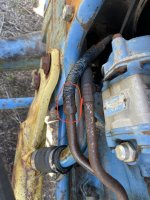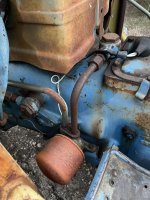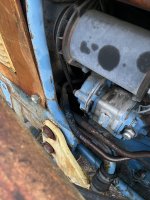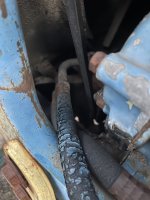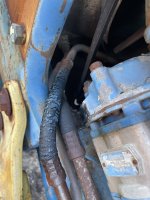Sorry, in my eagerness to get something posted I did a really poor job in posing the question/facts clearly. I will clear this up now.
This is (from the best I can tell) a 1967 ford 4000 series industrial tractor with a 735 (or is it 753) back hoe and front end loader.
Again, from the best I can tell (more photos attached) both of these tubes/hoses seem to originate from banjo fittings on the transmission casing (I have the hydrostatic??? Power reversing transmission) and APPEAR to go to the bottom of the radiator… is this an oil cooler as well as a radiator?
I didn’t notice the leak at all until I fixed the blown hose on the backhoe, so I could actually get some hydraulic pressure, and filled it up, not all the way yet, with hydraulic fluid. I thought the transmission fluid was completely different, and isolated, from the hydraulic fluid, but this has me questioning that now.
So current questions are:
1 - With the power reversing transmission is the transmission fluid the hydraulic fluid? Or are the 2 systems completely isolated from each other.
Sorry, in my eagerness to get something posted I did a really poor job in posing the question/facts clearly. I will clear this up now.
This is (from the best I can tell) a 1967 ford 4000 series industrial tractor with a 735 (or is it 753) back hoe and front end loader.
Again, from the best I can tell (more photos attached) both of these tubes/hoses seem to originate from banjo fittings on the transmission casing (I have the hydrostatic??? Power reversing transmission) and APPEAR to go to the bottom of the radiator… is this an oil cooler as well as a radiator?
I didn’t notice the leak at all until I fixed the blown hose on the backhoe, so I could actually get some hydraulic pressure, and filled it up, not all the way yet, with hydraulic fluid. I thought the transmission fluid was completely different, and isolated, from the hydraulic fluid, but this has me questioning that now.
So current questions are:
1 - With the power reversing transmission is the transmission fluid the hydraulic fluid? Or are the 2 systems completely isolated from each other.
2 - are these tubes/hoses really going to/from the radiator? And if so I assume that the radiator has an oil cooler built into the bottom of it.
3 - I guess I need to try and get it off, and get it to the hydraulic house to get it rebuilt unless….. I go completely cheap on this and try and wrap it with tape to seal it… not sure how much pressure is on this hose. Just typing this makes me think that’s a REALLY DUMB IDEA….
4 - I have a McRae to a manual for the ford 4000 series but it is really just about the tractor…. It doesn’t touch on the hydraulics/back hoe/ loader…. Anyone have a link to info on the back hoe or loader?
5 - I think answers to the 4 questions above will raise another round of questions, but at least I will be one step closer to a solution.
5 - I think answers to the 4 questions above will raise another round of questions, but at least I will be one step closer to a solution.

